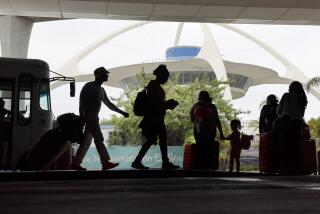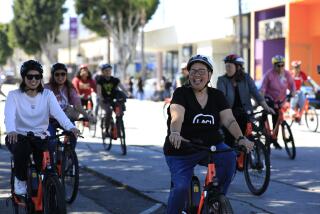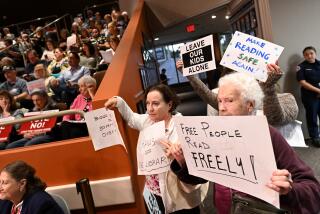Library Puts Robots Into Circulation : Technology: If CSUN’s computerized robotics system succeeds, it may solve the storage problem for other research centers.
- Share via
Plans for the new east wing of the Cal State Northridge library at first don’t seem very user-friendly, considering that they include shelves too high to reach, bad lighting and a lot of noisy equipment.
Even worse, all of the more than 500,000 books there will be kept in random order.
But what sounds like a librarian’s nightmare will work fine for the mechanical staffers of what will be the world’s first fully automated library, where robots will roam the aisles replacing and retrieving books, say California State University officials.
They say human hands will be no match for Leviathan II, the $2-million state-of-the-art automation system under construction at the San Fernando Valley campus.
When it’s finished, system designers say, Leviathan will hold 12 times the number of books per cubic foot as in a conventional library, allowing librarians to store the least-used of CSUN’s million-volume collection in a fraction of the space the books now occupy.
Patrons of the computerized card catalogue will, at the push of a button, command a team of six robots that can find a bin of books and bring it to the checkout counter in about five minutes. A human worker will pull the needed volume.
University officials estimate that the system--named after the biblical whale that “retrieved” Jonah--will save taxpayers millions of dollars in library construction costs and hundreds of thousands of dollars a year in operating costs. Leviathan works in the dark, does not litter and requires no heat.
The system is being built as part of an $18.5-million library expansion project to be completed in the fall of 1991.
Because only robots will be allowed to work in the Leviathan section, students and faculty will not be able to browse through the shelves of books, a practice that most agree is a fundamental component of research.
But if it works, Leviathan could be the answer for other university and research libraries faced with growing collections and dwindling space and money. Officials at the Library of Congress and Harvard University say librarians everywhere will be watching the CSUN experiment.
“Libraries can’t grow indefinitely,” said Michael Shelly, a special projects director at the Library of Congress, which is expected to outgrow its Capitol Hill facility in three years. “The net additions to just our bound volumes are in the neighborhood of 250,000 a year.”
Harley P. Holden, curator of the Harvard University archives, said “we’ll be taking a close look” at the CSUN system, because if it works, “it could be of great advantage.”
But skeptics, who include mostly academicians who prefer retrieving books themselves, say CSUN’s Leviathan could just as easily turn out to be a white elephant.
“I don’t think the books will come that fast or easy; it just seems that so many things can go wrong--the machinery screws up or the computer goes down,” said Leonard Pitt, who has been a CSUN history professor for 27 years. “Maybe that’s just the instinct of an old-fashioned professor.”
The critics point to a similar mechanical book-storage system that failed badly during an experimental run in the early 1970s. “Sometimes it worked and sometimes it didn’t,” said Nola Hartman, a reference librarian at the Monroe County Library in Bloomington, Ind., which built a new library to accommodate the system in 1969.
It later cost taxpayers about $250,000 to remove the system, called a Randtreiver, and convert its area for more conventional use. Besides the frequent mechanical breakdowns--it used giant magnets to lift metal book bins and place them on a conveyor belt--the system was inefficient because it could only be operated by specially trained library workers.
But robotics technology has advanced dramatically since then, say supporters of the CSUN plan.
Advanced computer-controlled retrieval systems are working well at hundreds of industry warehouses, including the world’s largest such system, in use for several years at the Ralphs Grocery Co. warehouse in Glendale. There, robots retrieve pallets of groceries weighing hundreds of pounds that are loaded by human hands onto trucks bound for area stores.
Officials at Eaton-Kenway Inc., builders of the Ralphs system, are also building the CSUN system. The firm is eager to prove that Leviathan will work and expects the idea to catch on at other universities.
Thomas Harris, director of library affairs for the Cal State University system and one of two men credited with pushing the idea, said he believes the system will work and eventually be tried at other Cal State campuses. “This promises to be very successful,” he said.
The biggest drawback to the automated setup is that researchers will be unable to walk through the aisles. Books stored in the automated system will be available only to the robots, which are modified forklifts with mechanical arms.
The robots will travel on rails in a narrow path between 100-foot-long aisles separating stacks of book bins that are 40 feet high. All of the volumes will have a computer bar code that tells Leviathan where to find them, or whether they have been checked out--making formal arrangement by subject unnecessary.
Some library users are complaining about the new system.
“I can’t tell you how many times I’ve gone into the library and found a book I needed next to the one I was looking for,” said David B. Friedman, a Fullbright scholar and attorney who also holds a doctorate in political economy from MIT.
Other experts in the field of library automation, such as UCLA mathematics professor Robert M. Hayes, agree that browsing is a key element in the search for information.
“The objections are not to automation but to equipment designs that interfere with direct access to the collection,” said Hayes, considered a pioneer in information science for the past 35 years.
Hayes, however, said universities, because of rising construction costs, have no choice but to try experiments such as the one at CSUN. Without the technology, the nation’s major universities, which are doubling their library collections every 15 to 20 years, would be buried in their books.
Almost everyone in the field agrees that such systems are a compromise between academic and economic demands.
“Even those like myself, who make a living in technology, haven’t gotten out of the habit of browsing for the serendipitous discovery,” said Richard Boss, a library automation consultant to the Office of the President, as well as the Boston and Los Angeles public libraries.
Common among the nation’s larger libraries are computerized card catalogue systems that list available book titles when library patrons use a terminal to enter either the subject or author they are seeking. CSUN patrons will be able to operate Leviathan using the school’s existing computerized card catalogue system.
“But that still is dependant on the choices of those cataloguing the material,” Boss said. “If I’m scanning shelves, I might be attracted by the cover, the title or the name of the person.”
Library administrators of the University of California system say they ran into similar opposition during planning for two book-storage facilities at Richmond, Calif., and UCLA. These traditional facilities employ library workers to shelve books. The facilities’ advantage, officials say, is that they save space at individual libraries by storing the overflow of volumes from the system’s nine campuses in two places.
“There are still very legitimate wishes to have all the books be on the shelves,” said Kay Loughman, head of user services for the system’s northern regional library storage facility. “But we’ve been in operation for several years now and performed well, getting materials quickly, so most of the fears have been allayed.”
Norman Tanis, CSUN’s dean of libraries, said Leviathan will be much quicker and more efficient than the University of California’s method.
Most of the library’s frequently used books will remain in traditional open stacks, Tanis said. Studies at the campus show that half of the library’s 1 million volumes account for 85% of the circulation, he said. Only books that have not been checked out in at least three years will become part of the Leviathan system.
Even during the busiest times, it will take no longer than 10 minutes for Leviathan to retrieve a book, CSUN officials said.
Promises of quick access to books have blunted most of the criticism by the faculty, especially considering that the automation system is only a part of major library expansion at CSUN. A second wing, which will include offices and additional library shelving, is also planned, said Henry Abrash, CSUN’s faculty president.
“I don’t think we could have gotten the funding for the expansion without it,” Tanis said of Leviathan. “It is the carrot that we think will work.”
The system will not mean a reduction in library employees, officials said. The same number will be needed because the most-used books will still be on traditional shelves, officials said.
Still, the only true measure of the system will be its reception by CSUN students and faculty, Tanis said. “The results are going to show up in the classroom.”
If the system works, it could be expanded to include even more of the library’s collection, officials said. If it doesn’t work, the university could use the space taken up by Leviathan in a more conventional way, said Doug Davis, the library’s associate dean for operations and planning.
Davis said he considers the odds “incredibly low” that Leviathan will fail. “The technology has been proven,” he said. “Thinking that it won’t work is like having a plan to convert your elevator shafts to closets.”
More to Read
Sign up for Essential California
The most important California stories and recommendations in your inbox every morning.
You may occasionally receive promotional content from the Los Angeles Times.










